Breast cancer surgery
![]() February, 19th, 2025
February, 19th, 2025
Summary
Learn about the types of operations used to treat breast cancer, including lumpectomy, mastectomy, lymph node surgery and breast reconstruction.
Overview
, Overview, ,
Breast cancer surgery is one treatment option for breast cancer. It involves removing the cancer with an operation. It’s often used in combination with other treatments. These other treatments can include radiation therapy, chemotherapy, hormone therapy and targeted therapy.
Surgery also may be used to reduce the risk of future cancer. This might be an option for people with a very high risk of breast cancer.
Breast cancer surgery includes different procedures, such as:
- Surgery to remove a portion of the breast tissue, called lumpectomy.
- Surgery to remove all of the breast tissue, called mastectomy.
- Surgery to remove nearby lymph nodes.
- Surgery to reconstruct a breast after mastectomy, called reconstructive surgery.
Which breast cancer operation is best for you depends on many factors. These include the size and stage of your cancer, your other treatment options, your goals and preferences, and other factors related to your health.
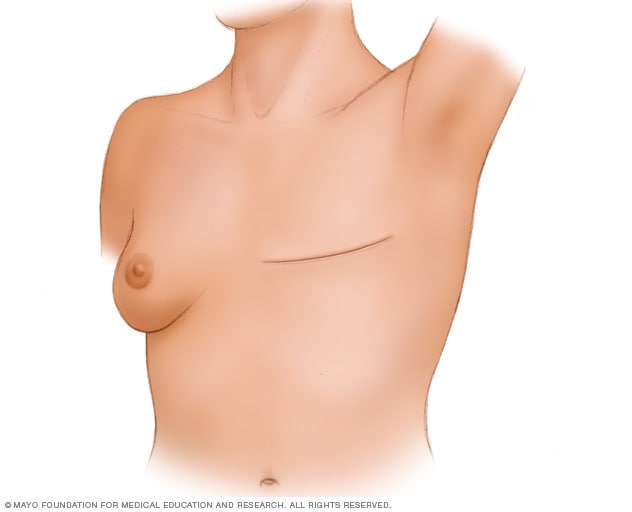
During a total mastectomy, the surgeon removes the breast tissue, nipple, areola and skin. This procedure also is known as a simple mastectomy. Other mastectomy procedures may leave some parts of the breast, such as the skin or the nipple. Surgery to create a new breast is optional. It may be done at the same time as mastectomy surgery or it can be done later.
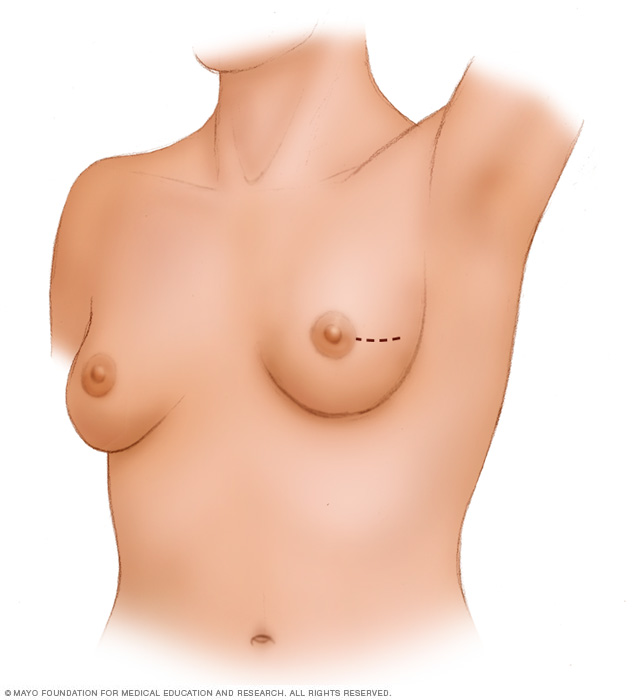
A lumpectomy involves removing the cancer and some of the healthy tissue that surrounds it. This illustration shows one possible incision that can be used for this procedure, though your surgeon will determine the approach that’s best for your particular situation.
Lumpectomy Why it’s done
The goal of breast cancer surgery is to remove cancer cells from the breast. For those who choose breast reconstruction, an additional goal may be to restore shape to the breast. This may be done at the same time or in a later operation.
Breast cancer treatment
Breast cancer surgery is a part of treatment for most breast cancers. It can be used to treat:
- Noninvasive breast cancer. Ductal carcinoma in situ, also called DCIS, is noninvasive breast cancer. Treatment typically starts with surgery. Other treatments are often used after surgery. Sometimes surgery is the only treatment needed.
- Early-stage breast cancer. Early-stage breast cancers include small cancers that haven’t spread outside of the breast. Treatment typically starts with surgery. Other treatments are often used after surgery.
- Locally advanced breast cancers. Locally advanced breast cancers include cancers that have grown larger. They may involve the breast skin or nearby muscles. Inflammatory breast cancer is an example of a locally advanced breast cancer. Treatment typically starts with medicine, followed by surgery. Other treatments are typically used after surgery.
- Recurrent breast cancer. Breast cancer that returns after initial treatment may be removed with additional surgery. Additional treatments may be recommended before and after surgery.
Surgery isn’t typically used to treat breast cancer that spreads outside the breast.
Breast cancer prevention
A preventive mastectomy is surgery to prevent breast cancer. It involves removing the breast tissue from both breasts in someone who doesn’t have breast cancer. It’s also called a prophylactic mastectomy or risk-reducing mastectomy. It might be an option if you have a high risk of breast cancer. This generally means having a strong family history of breast cancer or inherited DNA changes that increase the risk of cancer.
Risks
Breast cancer surgery is a safe procedure, but it carries a small risk of complications.
Risks that can happen soon after surgery include:
- Bleeding.
- Collection of fluid at the operative site, called a seroma.
- Infection.
- Pain.
- Problems with wound healing.
- Risks related to the medicine used to put you in a sleep-like state during surgery. These include confusion, nausea and vomiting.
Other risks can develop during recovery. These include:
- Arm swelling, called lymphedema, if lymph nodes are removed during surgery.
- Changes in the way you feel about your body or your appearance.
- Loss of or altered sensation in the chest and reconstructed breasts.
- Lasting pain.
How you prepare
Discuss your options with a breast cancer surgeon
Before surgery you will meet with a breast cancer surgeon. The surgeon explains your treatment options and what to expect from surgery. Prepare for this meeting by creating a list of questions to ask.
Questions to ask about surgery to remove the cancer:
- What are my options for breast cancer surgery?
- What factors may help me decide which surgery is best for me?
- How much of my breast needs to be removed?
Questions to ask about breast reconstruction:
- What are my options for reconstruction?
- Can the reconstruction be started at the same time as my cancer surgery?
- How many operations will I need?
- How will my breast look after surgery? Will my breasts look the same?
- If I don’t choose reconstruction, what will my breast look like?
Questions to ask about risks and recovery:
- Is surgery safe for me?
- How much time will I spend in the hospital?
- How much time will I need for recovery?
- Will I need to limit my activities after surgery?
- When can I return to work?
Breast cancer surgeons work closely with the surgeons who do breast reconstruction. These surgeons are called plastic surgeons or reconstructive surgeons. If you’re planning to undergo breast reconstruction, make an appointment to discuss these options, too.
What you can expect
During breast cancer surgery
Breast cancer surgery typically happens in a hospital. Before the procedure, you’re given medicine that keeps you in a sleep-like state. This medicine is called a general anesthetic.
What happens during your surgery will depend on the operation. In general, you can expect:
- An incision in the breast to remove the cancer. How much tissue is removed will depend on the procedure. The placement and length of the incision depends on the location of the cancer within the breast.
- Removal of some lymph nodes in the armpit. A sentinel node biopsy looks for signs that the cancer has spread to the lymph nodes. It involves removing a few of the lymph nodes into which a cancer is most likely to travel first. These are called the sentinel nodes. They’re tested for cancer.
- Closure of the incision. The surgeon closes the incision with stitches.
- Reconstruction, if you choose. If you want breast reconstruction, the reconstruction is often started at the time of your cancer operation. Sometimes reconstruction is done after all your treatments are finished. Breast reconstruction typically takes more than one operation to complete.
After breast cancer surgery
After your surgery, you can expect to:
- Be taken to a recovery room where your blood pressure, pulse and breathing are monitored.
- Have a bandage over the surgery site.
- Possibly have pain, numbness and a pinching sensation in your underarm area.
- Receive instructions on how to care for yourself at home. This includes taking care of your incision and drains, recognizing signs of infection, and understanding activity restrictions.
- Receive prescriptions for pain medicine and other medicines to help you control side effects of surgery.
- Resume your regular diet.
- Shower a day or two after surgery. Your healthcare team will give you specific instructions based on the type of surgery you had.
Most people don’t need to stay overnight in the hospital. It’s common to go home the same day. Sometimes it’s necessary to spend some time in the hospital to recover. Ask your healthcare team what you can expect.
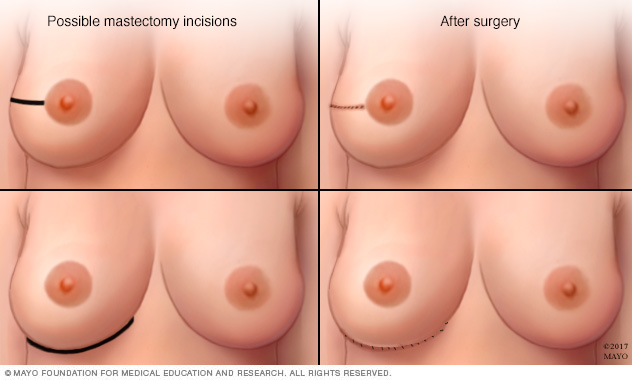
A nipple-sparing mastectomy involves removing the breast tissue and leaving the skin, nipple and areola. This illustration shows two examples of common incisions used for this operation. The surgeon chooses the incision based on the cancer’s location, size and other factors.
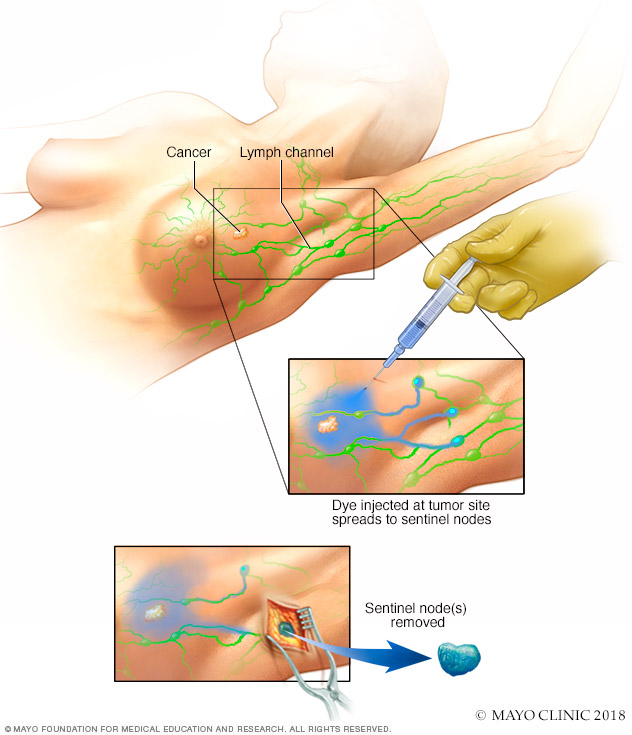
Sentinel node biopsy identifies the first few lymph nodes into which a tumor drains. The surgeon uses a harmless dye and a weak radioactive solution to locate the sentinel nodes. The nodes are removed and tested for signs of cancer.
Sentinel node biopsy Results
The results of your breast cancer surgery will show whether all of the cancer was removed. Ask your healthcare team when you can expect to know the results of your surgery. Your care team may talk about the results with you at a follow-up appointment. Or they may contact you with the results.
If you choose to have breast reconstruction, you may need more surgery. Breast reconstruction often takes more than one operation to complete.
Many people with breast cancer have other treatments after surgery. Common treatments used after surgery include chemotherapy, radiation therapy, hormone therapy and targeted therapy. When you might begin other treatments depends on your cancer. Ask your healthcare team what to expect.
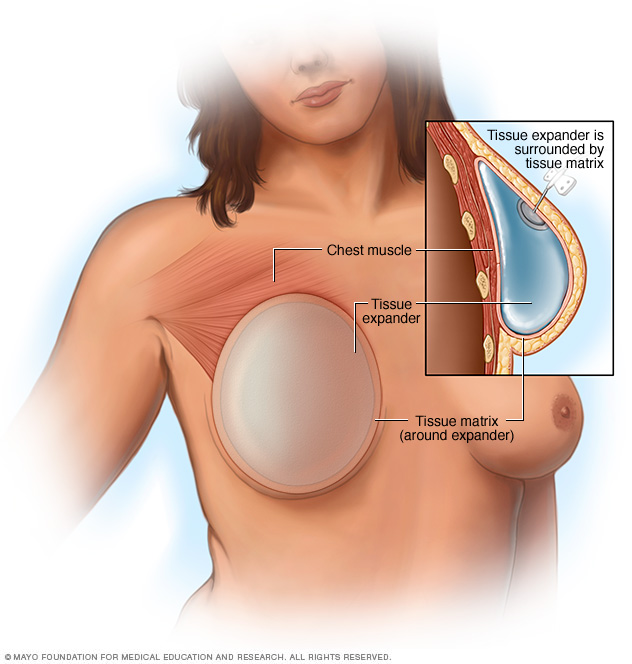
A breast implant that’s placed on top of the chest muscle is called a prepectoral breast implant. It’s often done in two operations. First, a plastic surgeon places a balloonlike tissue expander under the skin. Over a period of a few weeks to months, a healthcare professional may slowly fill the expander with saline to the size you prefer. In a second operation, a plastic surgeon removes the expander and replaces it with a breast implant.
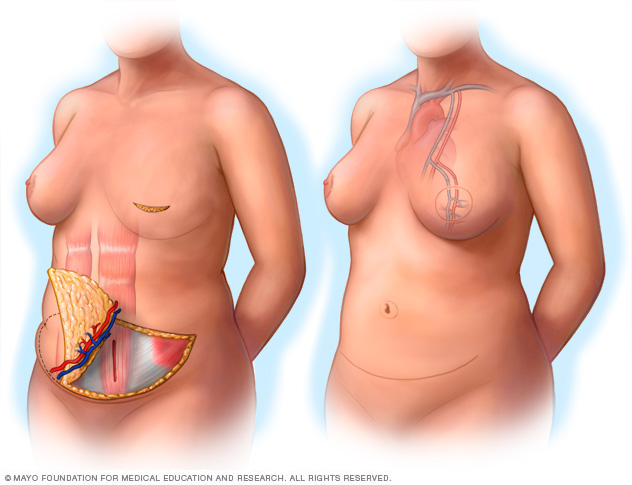
During a deep inferior epigastric perforator flap procedure, the surgeon removes a section of belly skin, fat and blood vessels for the new breast. This surgery also is called a DIEP flap procedure. The surgeon attaches the tissue to the blood vessels in the chest. The surgeon uses the tissue to create a new breast mound.
, DIEP flap,
© 1998-2025 Mayo Foundation for Medical Education and Research (MFMER). All rights reserved. Terms of Use



